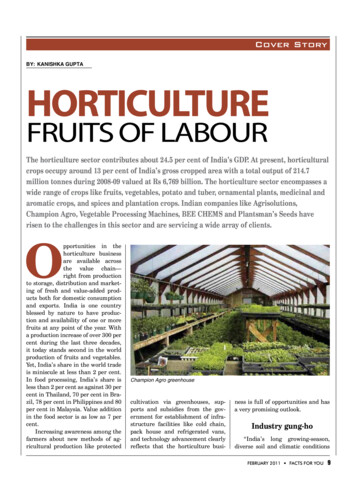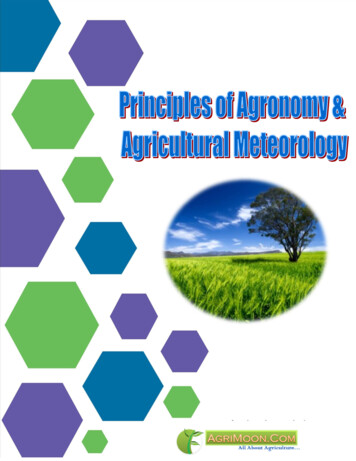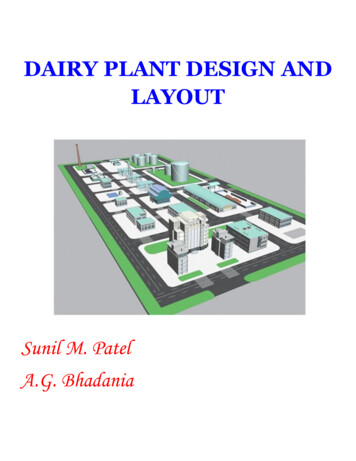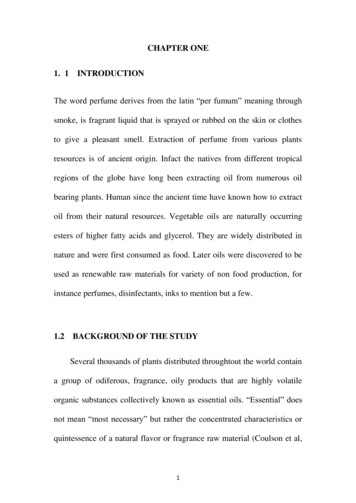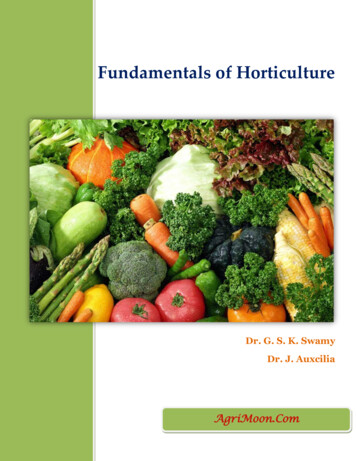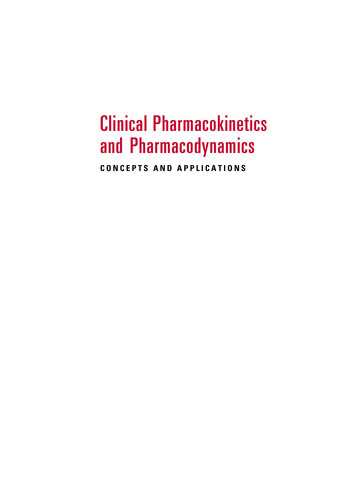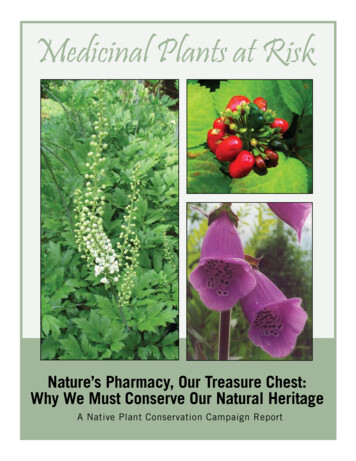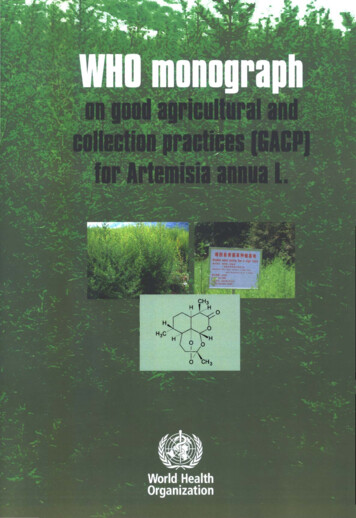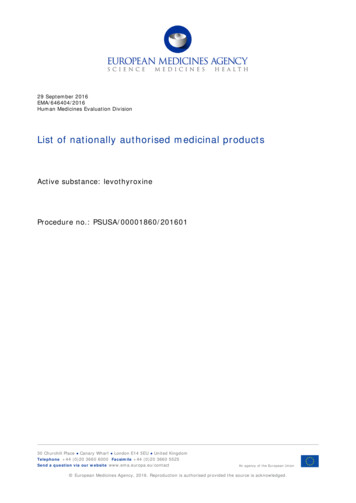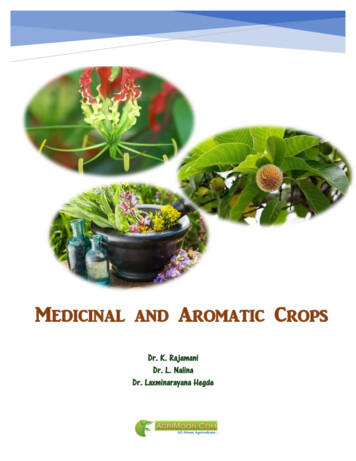
Transcription
Medicinal and Aromatic CropsDr. K. RajamaniDr. L. NalinaDr. Laxminarayana Hegde
Medicinal and Aromatic CropsCourse CreatorsDr. K. RajamaniProfessorDepartment of Medicinal & Aromatic CropsHorticultural College & Research InstituteTNAU, Coimbatore-3Dr. L. NalinaAssistant Professor (Hort.)Dept. of Medicinal and Aromatic Crops,Horticultural College & Research InstituteTNAU, Coimbatore-3Course ModeratorDr. Laxminarayana HegdeAssociate Professor of Medicinal and AromaticsKittur Rani Channamma College of HorticultureArabhavi, Gokak Tq, Belgaum Dist
Index1 History, scope, constraints and opportunities incultivation of medicinal and aromatic plants2 Coleus3 Glory lily4 Senna5 Periwinkle6 Phyllanthus7 Pyrethrum and Cinchona8 Rauvolfia and Belladona9 Dioscorea10 Isabgol11 Aloe12 Solanum viarum13 Mints (Mentha sp.)14 Piper longum15 Ashwgandha16 Guggul17 Opium Poppy18 Java Citronella19 Lemon Grass20 Palmarosa21 Vetiver22 Rosemary and Thyme23 Scented geranium24 Patchouli25 Ocimum26 Artemisia27 Ambrette28 French 0-145146-148149-151
2930313233Oil bearing roseTuberose (Polianthes tuberosa L.)LavenderOrganic production of Medicinal plantsGood Agricultural Practices for Medicinal plants152-157158-162163-166167-175176-194
Medicinal and Aromatic CropsLesson - 1History, scope, constraints and opportunities in cultivation of medicinal and aromatic plantsIntroductionPlants have been one of the important sources of medicines even since the dawn of humancivilization. In spite of tremendous developments in the field of allopathy during the 20th century,plants still remain one of the major sources of drugs in modern as well as traditional system ofmedicine throughout the world. Approximately one-third of all pharmaceuticals are of plant origin,wherein fungi and bacteria are also included. Over 60% of all pharmaceuticals are plant-based.Plants may have bioactive constituents like alkaloids, glycosides, steroids, phenols, tannin,antioxidants and other groups of compounds which may have marked pharmaceutical actions asanti-cancerous, anti-malarial, anti-helminthic or anti-dysentric, etc. Many of the essential oils, dyes,latex and even vegetable oils are also widely used as medicines. Many substances that go into makingup medicines are frequently products of living cells, although seemingly ‘waste’ or intermediate,metabolic compounds and not an integral part of the protoplasm and may have no obvious utility tothe plants.Out of nearly 4, 50,000 species of higher plants available, only a small proportion have beeninvestigated for medicinal properties and still a smaller number of plants yield well defined drugs.The same is the case with lower plants and with plants of the sea origin. Thus, the knowledge of plantconstituents gained so far is still meager, considering the huge number of species available in theworld. Approximately, only 10% of the organic constituents of plants are reported to be known andthe remaining 90% are yet to be explored.A very small proportion of Indian medicinal plants are lower plants like lichens, ferns,algae, etc. The majority of medicinal plants are higher plants. The major families in which medicinalplants occur are Fabaceae, Euphorbiaceae, Asteraceae, Poaceae, Rubiaceae, Cucurbitaceae, Apiaceae,Convolvulaceae, Malvaceae and Solanaceae.5www.AgriMoon.Com
Medicinal and Aromatic CropsDrugs are derived from trees, shrubs, herbs and even from primitive kinds of plants which do not fallinto the above categories. They are made from fruits (Senna, Solanum viarum, Datura, etc.), flowers(Butea monosperma, Bauhinia variegata), leaves (Senna, Datura, Periwinkle, Tylophora, etc.,), stems(Liquorice, Ginger, Dioscorea, Costus, Garlic), roots (Rauvolfia, Periwinkle, Ginseng, etc.,), seeds(Isabgol, Abrus, Nux vomica) and even bark (Cinchona).HistoryoooooooPlants have been associated with the health of mankind from time immemorial.In the past, sickness was viewed as a punishment by the gods and hence, was treatedwith prayers and rituals that included what may have been considered ‘magic potions’prepared out of local herbs.Archaeological discoveries from 60000 year old Neanderthal burial grounds in Iraqpoint to the use of several plants like marsh mallow, yarrow and groundsel that stillfigure in folk medicine.Mexican Indians are reported to have used peyote cactus for its hallucinogenic and, alsopossibly its healing properties for thousands of years.This plant is now known to have antibiotic properties as well.Cuneiform writing on clay tablets by the Sumerians of the Tigris and Euphrates(present day Iraq) around 4000 BC, reported the use of opium, liquorice, thyme,mustard and the chemical element sulphur as medicine.The Babylonians who apparently followed the Sumerians in this field added senna,coriander, saffron, cinnamon and garlic among the other herbs in their formulations.The importance of plantsPlants have been used by the mankind since prehistoric times for getting relief from sufferings andailments. Primitive people, when injured in battle or when they had a fall or cut, instinctivelyresorted to materials available at the reach of hand for stopping the flow of blood or for relievingfrom pain and, by trial and error, they learnt that certain plants were more effective than others. Manhas also gained such knowledge from his observation of birds and animals which use plants forcuring their ailments. Even today, we find that the domestic dog and cat, when they suffer fromindigestion or other ailments, run to the field, chew some grasses or herbs and vomit to get cured.The folk medicines of almost all the countries of the world abound in medicinal plants wealth, relychiefly on herbal medicine, even today.Today, chemical and pharmaceutical investigations have added a great deal of status to the6www.AgriMoon.Com
Medicinal and Aromatic Cropsuse of medicinal plants by revealing the presence of the active principles and their actions on humanand animal systems. Investigations in the field of pharmacognosy and pharmacology have providedvaluable information on medicinal plants with regard to their availability, botanical properties,method of cultivation, collection, storage, commerce and therapeutic uses. All these have contributedtowards their acceptance in modern medicine and their inclusion in the pharmacopeias of civilizednations.The practices of indigenous systems of medicine in India are based mainly on the use of plants.Charaka Samhita (1000 BC-100 AD) records the use of 2000 plants for remedies. Ancient medicinewas not solely based on empiricism and this is evident from the fact that some medicinal plantswhich were used in ancient times still have their place in modern therapy. Thus for example,‘Ephedra’ a plant used in China 4000 years ago is still mentioned in modern pharmacopoeias as thesource of an important drug, ephedrine. The plant Sarpagandha (Rauvolfia serpentina) which waswell known in India as a remedy for insanity is in existence today for curing mental ailments.Quinine, another important anti-malarial drug of modern medicine, was obtained from the cinchonatree.The knowledge about the use of medicinal plants has been accrued through centuries and suchplants are still valued even today, although synthetics, antibiotics, etc. have attained greaterprominence in modern medicine. It is, however, a fact that these synthetics and antibiotics althoughthey often show miraculous and often instantaneous results, prove harmful in the long run and thatis why many synthetics and antibiotics have now gone out of use or have been specified to beprescribed strictly under medical supervision. In the case of most medicinal plants, however, no suchcumulative derogatory effect has been recorded and that is why many of the medicines obtainedfrom plants are still widely used today.It is also true that lately, inspite of the rapid progress and spread of modern medicine, the popularityof herbal medicines is gaining momentum.Besides the above, the following are some of the reasons that make the large scale cultivation ofmedicinal plants inevitable.1. In nature, there remains a wide variation among the plants with regard to their activeprinciples. As only the best among them are used for cultivation, it enables us to obtainraw material of homogenous quality with high potency.2. It is easy to grow and fulfill the commitment of large scale demand through cultivatedsources rather than from natural sources, which mainly depend on nature for theirregeneration and availability.3. The increasing pressure of population and the development of roads into remote areashave resulted in deforestation and the eventual loss of natural plant resources.4. In many cases, the important plant parts used are roots or the entire plant, results indestructive collection/ extractive methods, which results in the extinction of manyspecies and ecotypes.5. Despite the fact that our forests are the major resource base for medicinal plants asmany of them appear in wild, the importance of conservation has not been clearly speltout. Any long-term strategy includes the conservation of biodiversity and support tothe communities which are solely dependent on forests for their livelihood.7www.AgriMoon.Com
Medicinal and Aromatic Crops6. The unauthorized collection of minor forest produce by persons who are led by theburgeoning demand for raw medicinal plant parts has led to the deprivation of therights and opportunities of the forest-dwelling communities.7. Since government of India provides policy support for promoting Indian system ofmedicine, the pharma industries look for organized supply of quality raw materials inlarger quantities.Future prospects and constraintsA comparative analysis of the prospects and constraints of the medicinal plant-based drug industryin our country reveals the following.Prospects1. The World Health Organization (WHO) has emphasized the need for better utilization of theindigenous system of medicine, based on the locally available medicinal plants in thedeveloping countries. In the USA and UK, plant-based drugs are being used in recent years ona considerable scale. The former USSR countries, East European countries and China haveadopted an integrated system of allopathic, traditional and folk systems of medicine. Duringthe last two decades, there has been a tremendous transformation of medical systems in theworld. Owing to the realization of the toxicity associated with the use of antibiotics andsynthetic drugs, Western countries are increasingly aware of the fact that drugs from naturalsources are far more safer. Therefore, there is an upsurge in the use of plant derived products.2. Medicinal plants and their derivatives will continue to play a major role in medical therapy inspite of advances in chemical technology and the appearance of cheap, synthesized, complexmolecules from simple ones through highly specific reaction mechanisms. The reactioninvolved is either difficult or expensive to duplicate by classical chemical method. For examplein Vitamin A, disogenin and solasodine of plants, where stearic forms are possible, chemicalsynthesis yields a mixture of the isomers which may be difficult to separate. The productobtained by synthesis may therefore be toxic or have a different therapeutic effect than what isobtained in nature.3. Drug development out of medicinal plants is less costlier than synthetic drug development.Reserpine is a good example of this. The synthesis of reserpine costs approximately Rs.1.25/g,whereas, commercial extraction from the plant costs only Rs.0.75 /g.4. The vast range of agro climatic conditions in India, varying from alpine/mild temperate totropical regions with abundant rains and sunshine make it an ideal place for the luxuriantgrowth of flora. India is endowed with incredible natural plant resources of pharmaceuticalvalue. Despite comprising only 2% of the land mass, India is blessed with 25% of thebiodiversity of the world. Over 7000 species of plants found in different ecosystems are said tobe used for medicine in our country. The Indian pharmacopoeia records about 100 medicinalplants available in India and their preparations. Out of these, quite a few are also recorded inthe pharmacopoeias of other countries of the world and there is a growing demand for them inthe international market.5. There has been a tremendous upsurge in the demand for phytopharmaceutical raw medicinalherbs and vegetable drugs of Indian origin from the Western nations. There is also an increasein domestic demand for raw material used for perfumeries, pharmacies and biopesticidalunits. The demand for traditional herbal drugs is also increasing rapidly mainly because of theharmful effects of synthetic chemical drugs and also because of an expansion of pharmaciesmanufacturing natural drug formulations.8www.AgriMoon.Com
Medicinal and Aromatic Crops6. Our country is the proud possessor of an impressive medical heritage which encompassesvarious systems of medicine, viz., Ayurveda, Siddha, Unani, folklore and grandma medicine.India has an invaluable treasure trove of various scriptures on diverse medical systems.7. India is the source of cheap labor and skilled manpower which readily absorbs technologicalchange and also adopts the same.8. Being strategically located in the world map, India could become a potential supplier ofphytopharmaceuticals, alkaloids and raw medicinal herbs for the emerging world market. Atpresent, India is not self-sufficient in pharmaceutical products, and drugs worth millions ofrupees have to be imported every year by the pharmaceutical industries in order to meet thenational demand for drugs. Hence it is necessary to bestow utmost attention to check theimport by producing the raw material and fine chemicals within the country.9. In addition, these crops have many virtues like drought hardiness, capability to grow onmarginal lands. They are relatively free from cattle damage and hence, can be profitablygrown in areas where stray cattle or wild animals or pilferage is a major problem. As it is,medicinal plants are better earners than many of the field crops. Since they are new crops,there is an immense scope for further improvement in their productivity and adaptability, inorder to obtain further increase in returns. They are suitable for incorporating into varioussystems of culture like intercropping, mixed cropping and multi tier cropping.Constraints1. Although India is a leading exporter of medicinal plants in the world, the rate of growth ofthese crops in relation to their economic prospects is not at all satisfactory. The reasons for thisapparent backwardness are many and varied.2. So far, there has been no organized research set-up to continually recharge scientific inputs inorder to make their cultivation not only economically viable but also more profitable, so thatthey can claim their due share in the cropping systems of the country.3. In spite of the thrust given by the government of India through the institutions like the Centrefor Medicinal and Aromatic Plants (CIMAP): the Regional Research Laboratories (RRL), atJammu, Bhubaneshwar and Jorhat; Directorate of Medicinal & Aromatic Plants (DMAPR),National Botanical Gardens, Forest Research Institutes, state Cinchona Directorates in TamilNadu and West Bengal, the replenishment of renewable inputs like quality planting materialof improved varieties, developing extension literature, organizing training and quality testing,are very limited because of the number of medicinal plants as well as their divergent uses.4. The other major constraint is marketing of the cultivated raw material because of the qualityconsiderations. Lack of testing facilities at the procurement and trading centres together withunscrupulous market handling, results in wide fluctuations in prices, often going down touneconomic and unrealistic levels. Thus, speculative trade has been one of the most seriousdeterrent to the development of this enterprise.5. The systematic cultivation of a few medicinal plants has been found to be a discouragingenterprise, mainly because of the uneconomical price they command. For example the saleprice of Phyllanthus amarus is as low as Rs.10/kg, making it a commercially unviableproposal. There is a need for the user industry to come forward and ensure that the cultivatedproduct is going to be homogeneous, in comparison to those collected from natural sources,where there is possibility for wide variation.6. Although most of them are industry oriented crops, the pattern of land-holdings does not lenditself for commercial cultivation on an extensive scale. In case of a few plants, viz., aonla,9www.AgriMoon.Com
Medicinal and Aromatic Cropsasoka, arjun, bael, nutmeg, neem, the cultivation involves a long gestation period due to whichmany farmers are reluctant to grow them.7. Unstable market conditions have also kept farmers away from taking up cultivation of thesecrops. The prices of certain crops like Holostemma annulare fluctuate greatly; the price of thecrop/kg ranged from Rs. 70/kg in 1993 to Rs. 240/kg in 1990.8. In the phytopharmaceutical industry, presently, no quality standards have been fixed, eitherfor the raw material or the final product and, as such, one finds wide variation in the qualityspecifications.9. Difficulty in proper identification of medicinal plants has led to the use of adulterants ormimics. Physical verification is also a difficult proposition, mainly because the plant part usedin many cases like the barks, roots, etc, show close resemblance. The only way to checkadulterants would be by chemical examination.10. The package of practices for number of medicinal plants has not been standardized to suitdifferent agro ecological conditions.11. The supply of raw material for the phytopharmaceutical industry is virtually monopolized. Itis found that supply and price patterns are often determined by the minor forest producecontractors/gatherers.12. In a number of cases the produce has to be used fresh for which instant transportation is amust, and in many cases it cannot be stored for long periods as this would entail fumigationwhich at times, results in chemical contamination of the raw material and eventually the finalproduct, because of its residual effect. Generally, the maximum period for which plantmaterial should be stored is around 5-6 months and no more.13. To overcome these constraints, it is necessary to organize the cultivation of medicinal crops onspecific regional basis and organize their marketing on similar lines as that of other cash cropslike coffee, tea cardamom, to maximise their production and returns. In fact, in some states likeTamil Nadu, there are some organized production systems like contractual farming, groupfarming which are exclusively engaged in the production, procurement and marketing of thesecrops.Future prospects and constraints1. India with its vast biodiversity and potential for commercial exploitation, could become aworld leader in the supply of raw material for the phytopharmaceutical industry.2. By drawing up a comprehensive strategy for the cultivation and conservation of medicinalplants in league with the forest departments, many threats outlined earlier could be turnedinto opportunities for successful commercial exploitation without tampering with the interestof the communities involved in the collection of medicinal plants.3. The introduction of medicinal plants into the crop rotation especially in dry land andwatershed areas could provide a strong thrust to the cultivation of medicinal plants.Aromatic crops Out of the nearly 4,50,000 species known to mankind , about 2000 species, which come fromabout 60 botanical families, contain essential oils. The families-Pinaceae among thegymnosperms, Apiaceae, Myrtaceae, Rutaceae, Lauraceae, Lamiaceae, Asteraceae (dicots),Poaceae, Aracaceae, Zingiberaceae and Amaryllidaceae (monocots) among the angiosperms,account for a large number of plants bearing essential oils of commercial importance.10www.AgriMoon.Com
Medicinal and Aromatic Crops The volatile oils occur in varied parts of the plant anatomy-in some cases being found all overthe plant body, in others being restricted to one special portion of the plant. Thus, in theconifers, of which the pine is a type, volatile oil is found all over the various parts; whereas inthe rose, the oil is confined to the petals; in cinnamon, to the bark and the leaves; in the orangefamily, chiefly to the flowers and the peel of the fruit; in aromatic grasses and mints, to theleaves, in ambrette, cumin, fennel, etc, in seeds and in vetiver in the roots. In plants, theseessential oils are produced in specialized glandular cells. In the case of the leaves and petals,the essential oils are contained in the innermost membrane of the cell-wall in parenchymatoustissue. In other plants, they accumulate as floating drops in the protoplasm (e.g.terpenes inorange peels) or in separate cell cavities.HistoryThe history of the use of aromatics dates back through many ages and many civilizations. It is,however, difficult to pinpoint when exactly man first used essential oils. Obviously, it must beprehistoric. The sense of smell plays a significant role for man in the identification of the right type offood. Most of the fruits, when ripe and fit for consumption, emit a pleasant smell or aroma. Thepleasant smell of flowers attracts insects and this helps in the cross-pollination, so essential oils haveplayed a vital role, directly as well as indirectly, in the life of man since appearance on the Earth as aresult of evolution. Plants have played a central part in many cultures over many eras. On a closestudy of the subject, it soon becomes clear just how vast was the knowledge of ancient civilizationsincluding that of Egypt, India, Arabia, China and Greece about plants, their properties and their uses.India has enjoyed a pre-eminent position in the manufacture of superior perfumes and aromaticssince ancient times and the industry has flourished and grown considerably. The famous Chinesetraveler Fa-Hien described India as the land of aromatic flowers fruits, woods, roots resins andgrasses. Fragrances were very expensive and were used mostly in worship as incense. In ancientIndia, perfumers were important traders; they were called ‘gandhikas’, who created their own blendsof perfumes and incense in the form of liquid, sticks, powders, pastilles and pastes: In Sanskritliterature, there is description of the toilette of a Mauryan queen, where her perfumes were freshlymade by her maid. Sandalwood was grated on a wet stone, spices pounded in a pestle, then the pasteblended in oil and sweet smelling flowers and leaves added to them. In the Ain-e-Akbari, Abul Fazalmentions Akbar’s love of attar and incense, “daily burnt in gold and silver censers”. At a later date,an apocryphal tale credits the Empress Noorjehan with discovering the attar of roses. She is said tohave noticed the rose-oil floating on the surface of her bath-water and, thus, the legendary attar ofrose was born.At nawabi banquets, guests were welcomed with attar. They were sprinkled with rose-water at thegate and then phayas, small swabs of cotton dipped in attar, would be offered to them on silver traysdecorated with flowers. Even the containers spelt luxury; attardaans were made of carved ivory orchased silver in the shape of mangoes or preening peacocks. The dressing table of a medieval lady’sboudoir would have a lacquer box holding a row of small cut-glass vials of attar. The silver rosewater sprinklers were shaped like long-stemmed flower vases and covered in filigree work. Indiancities like Delhi, Agra, Kannauj, Lucknow, Jaunpur, Ghazipur, Aligarh, Bharatpur, Mysore, andHyderabad, emerged as centers of the national and international trade in perfumery and otheraromatic compounds, and were known for their quality attars across Asia, Europe and Africa.11www.AgriMoon.Com
Medicinal and Aromatic CropsPresent statusThe world’s total production of essential oils is estimated at about 1,00,000 – 110000 t, and Indiastands third with a share of 16-17%. In value terms again, India’s position is No.2 and its share is 2122%. This is because of the mint revolution in North India. Brazil with its production of citrus oil at40000 t is the largest producer of essential oils in the world. However, its share in value terms is 90%while USA is the largest producer and consumer of essential oils.Most of the essential oils produced are marketed within the country. Also, many of them areexported. These oils are very expensive and earn good revenue in terms of foreign exchange.The export of perfumery products from India has risen to Rs. 630.28 crores during 2000-01. India alsoimports some of these items worth nearly Rs.265.58 crores annually. Among the essential oilsexported from India are Japanese mint oil, peppermint oil, sandalwood oil, jasmine and tuberoseconcretes and many other natural and synthetic perfumes in small quantities. Besides menthol, attars(all-kinds), red sandalwood powder, synthetic camphor, thymol, pepper oil ginger oil, davana oil andspearmint oil are also exported. India also imports a variety of essential oils such as geranium, anise,patchouli, orange, lavender, nutmeg, peppermint, citronella (Java), synthetic essential oils, etc, alongwith many other natural and synthetic perfumes.CONSTRAINTSAccording to one estimate, against the world trade of Rs.11,900 crores, the Indian share is only2%. This clearly indicates that the rate of growth of these crops in relation to their economic prospectsis not at all satisfactory. Perhaps inefficient organization, lack of research, unplanned exploitation ofnatural resources, failure to grow them on a large scale, inferior methods of production, malpracticesand adulteration are some of the reasons for present poor state of affairs. It is unfortunate that withalmost all types of climate and soil existing in our vast country, the possibilities of raising large-scaleplantations of essentials oil bearing plants on scientific lines has not been explored. It is a pity thatinterspaces in the perennial plantations, vast stretches of forests and lands as barren, waste andmarginal are lying fallow, when they can be gainfully used to raise aromatic raw materials.12www.AgriMoon.Com
Medicinal and Aromatic CropsThe inadequate research support for the cultivation of aromatic crops and extraction of essential oilsand perfumes is visible in spite of many of the institutions that undertake research on aromatic cropsin India.Future ProspectsThe future for aromatic crops, however, seems bright due to the following reasons1. It is realized now that perfumes and essential oils are not the articles of luxury as they werein the past. The demand for essential oils is increasing day by day with the advancement ofeducation and prosperity in the country. Fragrance plays a vital role in securing consumeracceptability in almost every product used. Essential oils are now a basic raw material forconsumer products meant for mass consumption. At least two hundred essential oils areused often and another eight hundred find occasional application. Similarly, about a dozenexpressed oils, and a dozen flower absolutes and a few oleoresins and gum resin oils are alsoused. There is a definite trend seen in the revival of plant-based aromatic chemicals in reportsfrom medical centers regarding the potential carcinogenic hazards of synthetics. On the otherhand, aromatic plants and essential oils freshen the environment. They also representrenewable resources.2. The search for natural resources has been intensified as synthetics have failed to provideversatility and a situation of saturation and later stagnation started developing. Improvedinstruments and chemicals also and thus helped in the search for new aromatic compounds.3. The aroma therapy is gaining momentum across the world and the interest in aromatics fortheir therapeutic value is also increasing due to the worldwide scare of the side-effects ofsynthetics and the revival of interest in herbs.4. Natural essential oils have the potential of being very safe insecticides. One good example inthis regard is of the essential oil obtained from Acorus calamus which has ß-asarone as anactive principle, and produces sterility among a variety of insects of either sex. It has beenfound very effective and safe for the storage of food grains.5. Apart from the above facts, essential oil crops are much better earners and, value-wise, theirtransportation cost is also much lower. Aromatic crops ought to get a high priority, next tofood.6. The growing and processing of aromatic crops is labour-intensive and, hence, generates lotof employment.7. Their spent waste can be converted into boards and can be used as a mulching material orploughed back into the soil to improve its tilth.8. Most of these raw materials are produced in the tropics, in the developing countries of Asiaand Africa from where they go to Europe and the USA for use in the manufacture ofperfumery chemicals, cosmetics, food flavours and a host of other consumer products which,in turn, are distributed all over the world.9. Thus, they provide a natural asset to these countries for the export trade.oDespite many odds, India has still been maintaining a leading position in the productionand trade of several essential oils. However, it is now facing stiff competition from otherdeveloping countries in several traditional commodities, both for quality and price, any13www.AgriMoon.Com
Medicinal and Aromatic Cropsslackness at this stage in these parameters may be disadvantageous to India in terms ofinternational trade. It, therefore, needs intensive research efforts in farm production andprocessing tech
indigestion or other ailments, run to the field, chew some grasses or herbs and vomit to get cured. The folk medicines of almost all the countries of the world abound in medicinal plants wealth, rely chiefly on herbal medicine, even today. Today, chemical and pharmaceutical

